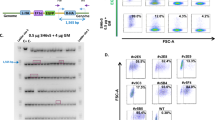Abstract
Targeted integration of foreign DNA is ideal for gene therapy, particularly when target cells such as hematopoietic cells actively divide and proliferate. Adeno-associated virus (AAV) has been shown to integrate its genome into a defined locus, AAVS1 (19q13.3-qter). The inverted terminal repeat (ITR) and Rep proteins are responsible for this site-specific integration, and a system has been developed that delivers a gene preferentially into AAVS1 by using these components of AAV. We examined whether this system could be applied to gene transfer into K562 cells. Tworep expression plasmids were tested, 1 driven by the cytomegalovirus (CMV) promoter (pCMVR78) and the other under the translational control of an internal ribosome entry site (pMGiR78) with mouse mammary tumor virus promoter. K562 cells were cotransfected with arep plasmid and a plasmid containing aneo gene flanked by the ITRs. G418-resistant clones were isolated and analyzed by Southern blot analysis and fluorescence in situ hybridization (FISH). Southern blot analysis suggested AAVS1-specific integration of theneo gene in 6 (35%) of 17 clones when K562 cells were transfected with pMGiR78 by lipofection. FISH located theneo gene on chromosome 19 in 5 of these 6 clones (29%). Eight (32%) of 25 clones obtained by electroporation with pCMVR78 had theneo gene at AAVS1, according to Southern blot analysis, and 4 of these 8 clones (16%) were positive according to FISH analysis. These results suggest that site-specific integration of foreign DNA can be achieved at a significantly high rate in human hematopoietic cells using the A AV components.
Similar content being viewed by others
References
Kume A, Hanazono Y, Mizukami H, et al. Hematopoietic stem cell gene therapy: a current overview.Int J Hematol. 1999;69:227–233.
Verma IM, Somia N. Gene therapy: promises, problems and prospects [news].Nature. 1997;389:239–242.
Naldini L, Blomer U, Gallay P, et al. In vivo gene delivery and stable transduction of nondividing cells by a lentiviral vector.Science. 1996;272:263–267.
Smith AE. Viral vectors in gene therapy.Annu Rev Microbiol. 1995;49:807–838.
Russell DW, Kay MA. Adeno-associated virus vectors and hematology.Blood. 1999;94:864–874.
Kotin RM, Siniscalco M, Samulski RJ, et al. Site-specific integration by adeno-associated virus.Proc Natl Acad Sci U S A. 1990;87:2211–2215.
Kotin RM, Menninger JC, Ward DC, et al. Mapping and direct visualization of a region-specific viral DNA integration site on chromosome 19q13-qter.Genomics. 1991;10:831–834.
Kotin RM, Linden RM, Berns KI. Characterization of a preferred site on human chromosome 19q for integration of adeno-associ-ated virus DNA by non-homologous recombination.EMBO J. 1992;11:5071–5078.
Samulski RJ, Zhu X, Xiao X, et al. Targeted integration of adeno-associated virus (AAV) into human chromosome 19.EMBO J. 1991;10:3941–3950.
Linden RM, Ward P, Giraud C, et al. Site-specific integration by adeno-associated virus.Proc Natl Acad Sci U S A. 1996;93:11288–11294.
Weitzman MD, Kyöstio SR, Kotin RM, et al. Adeno-associated virus (AAV) Rep proteins mediate complex formation between AAV DNA and its integration site in human DNA.Proc Natl Acad Sci U S A. 1994;91:5808–5812.
Surosky RT, Urabe M, Godwin SG, et al. Adeno-associated virus Rep proteins target DNA sequences to a unique locus in the human genome.J Virol. 1997;71:7951–7959.
Kearns WG, Afione SA, Fulmer SB, et al. Recombinant adeno-associated virus (AAV-CFTR) vectors do not integrate in a site-specific fashion in an immortalized epithelial cell line.Gene Ther. 1996;3:748–755.
Yang CC, Xiao X, Zhu X, et al. Cellular recombination pathways and viral terminal repeat hairpin structures are sufficient for adeno-associated virus integration in vivo and in vitro.J Virol. 1997;71:9231–9247.
Fisher Adams G, Wong KK Jr, Podsakoff G, et al. Integration of adeno-associated virus vectors in CD34+ human hematopoietic progenitor cells after transduction.Blood. 1996;88:492–504.
Zhou SZ, Cooper S, Kang LY, et al. Adeno-associated virus 2-mediated high efficiency gene transfer into immature and mature subsets of hematopoietic progenitor cells in human umbilical cord blood.J Exp Med. 1994;179:1867–1875.
Goodman S, Xiao X, Donahue RE, et al. Recombinant adeno-associated virus-mediated gene transfer into hematopoietic progenitor cells.Blood. 1994;84:1492–1500.
Malik P, McQuiston SA, Yu XJ, et al. Recombinant adeno-associated virus mediates a high level of gene transfer but less efficient integration in the K562 human hematopoietic cell line.J Virol. 1997;71:1776–1783.
Balague C, Kalla M, Zhang WW. Adeno-associated virus Rep78 protein and terminal repeats enhance integration of DNA sequences into the cellular genome.J Virol. 1997;71:3299–3306.
Pieroni L, Fipaldini C, Monciotti A, et al. Targeted integration of adeno-associated virus-derived plasmids in transfected human cells.Virology. 1998;249:249–259.
Shelling AN, Smith MG. Targeted integration of transfected and infected adeno-associated virus vectors containing the neomycin resistance gene.Gene Ther. 1994;1:165–169.
McCarty DM, Christensen M, Muzyczka N. Sequences required for coordinate induction of adeno-associated virus p19 and p40 promoters by Rep protein.J Virol. 1991;65:2936–2945.
Urabe M, Hasumi Y, Kume A, et al. Charged-to-alanine scanning mutagenesis of the N-terminal half of adeno-associated virus type 2 Rep78 protein.J Virol. 1999;73:2682–2693.
Giraud C, Winocour E, Berns KI. Site-specific integration by adeno-associated virus is directed by a cellular DNA sequence.Proc Natl Acad Sci U S A. 1994;91:10039–10043.
Hermonat PL. Down-regulation of the human c-fos and c-myc proto-oncogene promoters by adeno-associated virus Rep78.Cancer Lett. 1994;81:129–136.
Hermanns J, Schulze A, Jansen-Dürr P, et al. Infection of primary cells by adeno-associated virus type 2 results in a modulation of cell cycle-regulating proteins.J Virol. 1997;71:6020–6027.
Shayakhmetov DM, Papayannopoulou T, Stamatoyannopoulos G, et al. Efficient gene transfer into human CD34(+) cells by a retargeted adenovirus vector.J Virol. 2000;74:2567–2583.
Author information
Authors and Affiliations
Corresponding author
About this article
Cite this article
Kogure, K., Urabe, M., Mizukami, H. et al. Targeted Integration of Foreign DNA Into a Defined Locus on Chromosome 19 in K562 Cells Using AAV-Derived Components. Int J Hematol 73, 469–475 (2001). https://doi.org/10.1007/BF02994009
Received:
Revised:
Accepted:
Published:
Issue Date:
DOI: https://doi.org/10.1007/BF02994009




